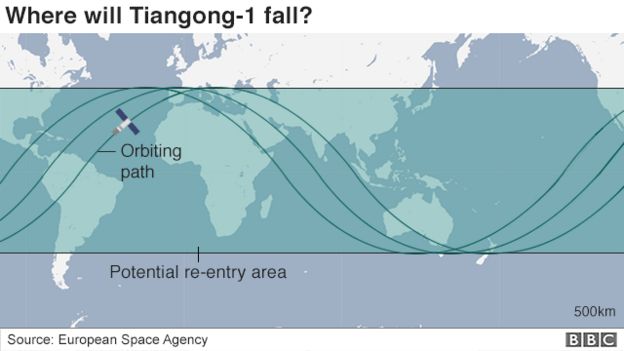 |
Jolly good
|
|
Join Date: Oct 2002
Posts: 29,429
|
|
|
Jolly good
Join Date: Oct 2002
Posts: 29,429
|
 Chinese space lab due to fall to Earth
Chinese space lab due to fall to Earth
Quote:
The estimated window of re-entry for the defunct Chinese space lab Tiangong-1 has narrowed sharply.
The timeframe for the fall to Earth is centred on 01:07 Monday GMT (02:07 BST), plus or minus two hours.
Experts are tracking the module as it orbits at an ever decreasing altitude.
However, they will only be sure of the timing of the final plunge very late in the descent because of the uncertainties over Tiangong's interactions with the high atmosphere.
China has lost communication with the module and there is no way to control its downward flight.
However, the risk of any parts of Tiangong hitting a populated area is considered very low.
"Given Tiangong-1 has a larger mass and is more robust, as it is pressurised, than many other space objects that return uncontrolled to Earth from space, it is the subject of a number of radar tracking campaigns," explained Richard Crowther, the UK Space Agency's chief engineer.
"The majority of the module can be expected to burn up during re-entry heating, with the greatest probability being that any surviving fragments will fall into the sea," he told BBC News.

Precise knowledge of the re-entry time and location will come late
Typically, only in the last hour or so are experts very confident
Most of the module's components will burn up in the high atmosphere
Its orbital path means any debris is restricted in where it can fall
Perhaps 20-40% could survive to the surface - that's 1.5-3.5 tonnes
The highest probability is that this material would hit the ocean
Any debris path at the surface would be hundreds of km long
Tiangong is the 50th most massive object to come back uncontrolled
Launched in 2011 and visited by six Chinese astronauts, the 10m-long, 8.5-tonne Tiangong module should really have been de-orbited in a planned manner.
Traditionally, thrusters are fired on large vehicles to drive them towards a remote zone over the Southern Ocean. But this option appears not to be available, especially after the loss of command links in 2016.
Tiangong is now brushing through the top of the atmosphere, which is dragging on the spacecraft and causing it to lose altitude rapidly.....
|
From http://www.bbc.co.uk/news/science-environment-43557446
|





















 Linear Mode
Linear Mode

